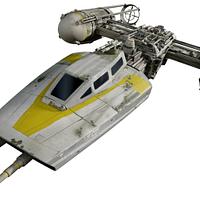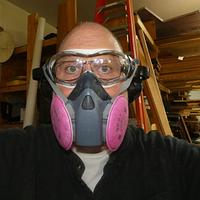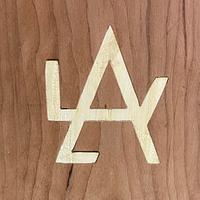Share your craft projects
Make new craft buddies
Ask craft questions
Blog your craft journey
How do I get this finish, or something like it?
I have a table that I made out of 2x4 and 4x4 lumber with steel bracing. I think I may convert it into a coffee table by shortening the legs. It looks pretty rough, but I thought I might go with that and give it a distressed/industrial look. I found a few examples:
How would I do this? I'm not fond of using a torch since I live in SoCal and it's coming up on fire season. I thought I might stain it black and sand off some, then go over it with clear or a light brown, or maybe a color like bluish gray. Any ideas/suggestions?
Jeff
7 Replies
I do think a torch would be your best bet but you're by no means lighting on fire, just a controlled and localized charring. Sand it back to your desired distressed look and brush on some polyurethane, lacquer or your finish of choice. If you've got a jar of old hardware laying around, you could spread some on a hard surface like concrete and drop the board onto it a few times before firing up the torch for a truly worn look.
Depending on what you’re looking for, a light gauge chain (like links less than an inch long) can be lightly whipped against the wood…giving a nice distressed look, IMO. I’d second the torch work…if you’re trying to match the pics you posted.
Ryan/// ~sigh~ I blew up another bowl. Moke told me "I made the inside bigger than the outside".
Distressed is pretty easy, you just need some random, but while paying attention to wear areas. Like around a handle, or other areas where a functioning piece actually gets touched when in use.
then beat the snot out of it randomly, and with a variety of different tools, so the marks are different. Both heavy and light contacts. I've seen several pieces that were shot to inflict wounds. Shotgun blasts at 30 yards with about 6 shot can look pretty wild.
Paint and finishes in layers, and sanded at contact spots to reveal other colors below.
Once you start doing it, other thoughts will come to you, it's the opposite of a nice finish, and if you dislike finishing, it's oddly soothing. :-)
then beat the snot out of it randomly, and with a variety of different tools, so the marks are different. Both heavy and light contacts. I've seen several pieces that were shot to inflict wounds. Shotgun blasts at 30 yards with about 6 shot can look pretty wild.
Paint and finishes in layers, and sanded at contact spots to reveal other colors below.
Once you start doing it, other thoughts will come to you, it's the opposite of a nice finish, and if you dislike finishing, it's oddly soothing. :-)
It depends a little on whether you want the finish to actually be distressed or just look distressed. If you want it smooth, you probably do not want to create dents and such. You can use a torch to lightly char it and sand it back but the look you show looks more like smeared and splotchy stain than charring. Pine is naturally splotchy so that may work to your advantage. For that look, I would first sand it smooth just as you normally would to prep for a finish but not above 150 grit. You want the grain to remain fairly open to stain so it will absorb irregularly and splotch. You can raise the grain by wiping with water and not sanding it before you apply a stain. I would then get a dark stain and just haphazardly wipe it on with a cloth and even drip some a little heavy in spots but not wipe it off right away. You might need to thin the stain a little for a first pass and then full strength for a second pass but apply it heavier in places, especially any that look like they were splotchy to accent those areas. As you are applying the stain, wipe in random directions across the grain or in circular patterns but you probably want to minimize how many times you wipe each area. If you use a water based stain, you may be able to use a fairly wet rag to wipe off the excess stain, wiping across the grain and in random patterns and then dry the surface with a dry rag. Because you will have raised grain, you will probably want to lightly sand with a higher grit but sand by hand being carefully not to remove too much of the stain. If the pine is splotchy you can probably sand more because the stain will have absorbed deeper in those spots. Finish with what ever top coat you want.
Another option is to buy some spray paint and just randomly spray splotches onto the surface. You can start by just sort of spritzing the entire surface and then put some darker areas. After the paint dries, you can cover the entire surface with whatever topcoat you want.
It might not be a bad idea to cover the enter surface with a sanding sealer or shellac based primer like Zinsser Seal Coat before you apply whatever topcoat you want. Minwax has a water based sanding sealer for poly that I have had good luck with. The sealer will allow you to sand it smooth after distressing the stain and still get a smooth coat with whatever gloss level you want. The shellac sealer may also help if you use a spray paint that may not be compatible with the top coat.
Do your experimenting on the bottom of the table top. You can try different techniques to figure out which ones give you the look you want and you can always sand it back and start over if you do not like it
Another option is to buy some spray paint and just randomly spray splotches onto the surface. You can start by just sort of spritzing the entire surface and then put some darker areas. After the paint dries, you can cover the entire surface with whatever topcoat you want.
It might not be a bad idea to cover the enter surface with a sanding sealer or shellac based primer like Zinsser Seal Coat before you apply whatever topcoat you want. Minwax has a water based sanding sealer for poly that I have had good luck with. The sealer will allow you to sand it smooth after distressing the stain and still get a smooth coat with whatever gloss level you want. The shellac sealer may also help if you use a spray paint that may not be compatible with the top coat.
Do your experimenting on the bottom of the table top. You can try different techniques to figure out which ones give you the look you want and you can always sand it back and start over if you do not like it
--Nathan, TX. Hire the lazy man. He may not do as much work but that's because he will find a better way.
Based on a whole bunch of first hand experience:
(1) Like was said, you're not starting a fire, you are just charring the surface.
(2) Keep a spray bottle of water to tame what you don't like.
(3) Rather than sand, start off with a wire brush. I prefer a small brass one, because it's not as aggressive as a wire brush we'd use out in the machine shop.
(4) After brushing, then I'd touch up with sanding. Start with just a piece of paper in your hand, because a sander works fast and you can better control when you want to stop with just a piece of sandpaper.
(5) If you want the dark splotchy, a little black, water based dye would get you there. Less would, probably, be better, because, like water color on paper, results happen quick and, with the penetration of a dye, there isn't much in the way of going back to go (though a bleach might get you there).
That dye can, also, lend itself to the distress effect. For example, a toothpick touched in the dye, then touched to the surface may get you where you want to be.
(6) Don't forget, the wood you use has two sides, so you can experieent.
(1) Like was said, you're not starting a fire, you are just charring the surface.
(2) Keep a spray bottle of water to tame what you don't like.
(3) Rather than sand, start off with a wire brush. I prefer a small brass one, because it's not as aggressive as a wire brush we'd use out in the machine shop.
(4) After brushing, then I'd touch up with sanding. Start with just a piece of paper in your hand, because a sander works fast and you can better control when you want to stop with just a piece of sandpaper.
(5) If you want the dark splotchy, a little black, water based dye would get you there. Less would, probably, be better, because, like water color on paper, results happen quick and, with the penetration of a dye, there isn't much in the way of going back to go (though a bleach might get you there).
That dye can, also, lend itself to the distress effect. For example, a toothpick touched in the dye, then touched to the surface may get you where you want to be.
(6) Don't forget, the wood you use has two sides, so you can experieent.
Shotgun blasts at 30 yards with about 6 shot can look pretty wild.
BB 3.5" high brass can look pretty wild too.
Thanks to all. I've got some good ideas here.
I put the project on hold; I don't really like the way the finished table looks and can't seem to figure out what to do with it. It was going to be one of two workbenches, but that plan looked better on paper than in person, so I have an extra workbench. I was able to take it apart and store it out of the way for now. I think I will let it sit and not think about it for awhile and something will occur to me. My initial thoughts are to cut it down and make several smaller tables, make it a coffee table with shorter legs, or make a desk for one of my boys. It's too rough and will look out of place in the house, but I'd have to really paint it well to keep it outside. I was originally going to put a steel top on it, but I may gather some wood to make some sort of butcher block style top. I thought the rough finish I asked about would be appropriate to the look as well.
I put the project on hold; I don't really like the way the finished table looks and can't seem to figure out what to do with it. It was going to be one of two workbenches, but that plan looked better on paper than in person, so I have an extra workbench. I was able to take it apart and store it out of the way for now. I think I will let it sit and not think about it for awhile and something will occur to me. My initial thoughts are to cut it down and make several smaller tables, make it a coffee table with shorter legs, or make a desk for one of my boys. It's too rough and will look out of place in the house, but I'd have to really paint it well to keep it outside. I was originally going to put a steel top on it, but I may gather some wood to make some sort of butcher block style top. I thought the rough finish I asked about would be appropriate to the look as well.
Jeff












